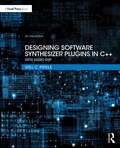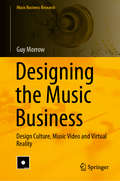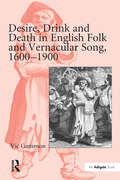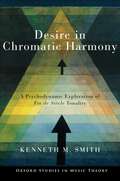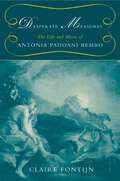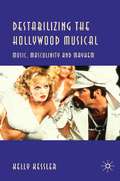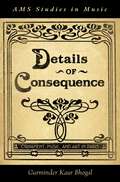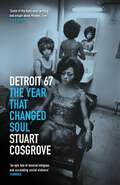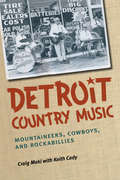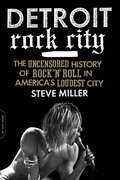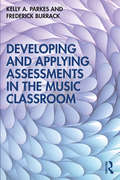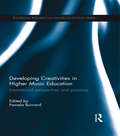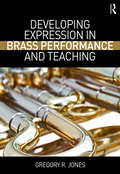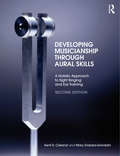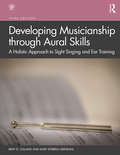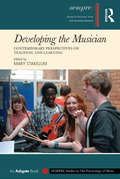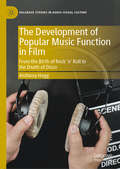- Table View
- List View
Designing Software Synthesizer Plugins in C++: With Audio DSP
by Will C. PirkleDesigning Software Synthesizer Plugins in C++ provides everything you need to know to start designing and writing your own synthesizer plugins, including theory and practical examples for all of the major synthesizer building blocks, from LFOs and EGs to PCM samples and morphing wavetables, along with complete synthesizer example projects. The book and accompanying SynthLab projects include scores of C++ objects and functions that implement the synthesizer building blocks as well as six synthesizer projects, ranging from virtual analog and physical modelling to wavetable morphing and wave-sequencing that demonstrate their use. You can start using the book immediately with the SynthLab-DM product, which allows you to compile and load mini-modules that resemble modular synth components without needing to maintain the complete synth project code. The C++ objects all run in a stand-alone mode, so you can incorporate them into your current projects or whip up a quick experiment. All six synth projects are fully documented, from the tiny SynthClock to the SynthEngine objects, allowing you to get the most from the book while working at a level that you feel comfortable with. This book is intended for music technology and engineering students, along with DIY audio programmers and anyone wanting to understand how synthesizers may be implemented in C++.
Designing the Music Business: Design Culture, Music Video and Virtual Reality (Music Business Research)
by Guy MorrowThis book addresses the neglect of visual creativities and content, and how these are commercialised in the music industries. While musical and visual creativities drive growth, there is a lack of literature relating to the visual side of the music business, which is significant given that the production of meaning and value within this business occurs across a number of textual sites.Popular music is a multimedia, discursive, fluid, and expansive cultural form that, in addition to the music itself, includes album covers; gig and tour posters; music videos; set, stage, and lighting designs; live concert footage; websites; virtual reality/augmented reality technologies; merchandise designs; and other forms of visual content. As a result, it has become impossible to understand the meaning and value of music without considering its relation to these visual components and to the interrelationships between them. Using design culture theory, participant observation, interviews, case studies, and a visual methodology to explore the topic, this research-based book is a valuable study aid for undergraduate and postgraduate students of subjects including the music business, design, arts management, creative and cultural industries studies, business and management studies, and media and communications.
Desire, Drink and Death in English Folk and Vernacular Song, 1600-1900
by Vic GammonThis much-needed book provides valuable insights into themes and genres in popular song in the period c. 1600-1900. In particular it is a study of popular ballads as they appeared on printed sheets and as they were recorded by folk song collectors. Vic Gammon displays his interest in the way song articulates aspects of popular mentality and he relates the discourse of the songs to social history. Gammon discusses the themes and narratives that run through genres of song material and how these are repeated and reworked through time. He argues that in spite of important social and economic changes, the period 1600-1850 had a significant cultural consistency and characteristic forms of popular musical and cultural expression. These only changed radically under the impact of industrialization and urbanization in the nineteenth century. The book will appeal to those interested in folk song, historical popular music (including church music), ballad literature, popular literature, popular culture, social history, anthropology and sociology.
Desire, Drink and Death in English Folk and Vernacular Song, 1600-1900
by Vic GammonThis much-needed book provides valuable insights into themes and genres in popular song in the period c. 1600-1900. In particular it is a study of popular ballads as they appeared on printed sheets and as they were recorded by folk song collectors. Vic Gammon displays his interest in the way song articulates aspects of popular mentality and he relates the discourse of the songs to social history. Gammon discusses the themes and narratives that run through genres of song material and how these are repeated and reworked through time. He argues that in spite of important social and economic changes, the period 1600-1850 had a significant cultural consistency and characteristic forms of popular musical and cultural expression. These only changed radically under the impact of industrialization and urbanization in the nineteenth century. The book will appeal to those interested in folk song, historical popular music (including church music), ballad literature, popular literature, popular culture, social history, anthropology and sociology.
Desire in Chromatic Harmony: A Psychodynamic Exploration of Fin de Siècle Tonality (Oxford Studies in Music Theory)
by Kenneth M. SmithHow does musical harmony engage listeners in relations of desire? Where does this desire come from? Author Kenneth Smith seeks to answer these questions by analyzing works from the turn of the twentieth- century that are both harmonically enriched and psychologically complex. Desire in Chromatic Harmony yields a new theory of how chromatic chord progressions direct the listener on intricate journeys through harmonic space, mirroring the tensions of the psyche found in Schopenhauer, Freud, Lacan, Lyotard, and Deleuze. Smith extends this mode of enquiry into sophisticated music theory, while exploring philosophically engaged European and American composers such as Richard Strauss, Alexander Skryabin, Josef Suk, Charles Ives, and Aaron Copland. Focusing on harmony and chord progression, the book drills down into the diatonic undercurrent beneath densely chromatic and dissonant surfaces. From the obsession with death and mourning in Suk's asrael Symphony to an exploration of "perversion" in Strauss's elektra; from the Sufi mysticism of Szymanowski's Song of the Night to the failed fantasy of the American dream in Copland's The Tender Land, Desire in Chromatic Harmony cuts a path through the dense forests of chromatic complexity, revealing the psychological make-up of post-Wagnerian psychodynamic music.
Desire in Chromatic Harmony: A Psychodynamic Exploration of Fin de Siècle Tonality (Oxford Studies in Music Theory)
by Kenneth M. SmithHow does musical harmony engage listeners in relations of desire? Where does this desire come from? Author Kenneth Smith seeks to answer these questions by analyzing works from the turn of the twentieth- century that are both harmonically enriched and psychologically complex. Desire in Chromatic Harmony yields a new theory of how chromatic chord progressions direct the listener on intricate journeys through harmonic space, mirroring the tensions of the psyche found in Schopenhauer, Freud, Lacan, Lyotard, and Deleuze. Smith extends this mode of enquiry into sophisticated music theory, while exploring philosophically engaged European and American composers such as Richard Strauss, Alexander Skryabin, Josef Suk, Charles Ives, and Aaron Copland. Focusing on harmony and chord progression, the book drills down into the diatonic undercurrent beneath densely chromatic and dissonant surfaces. From the obsession with death and mourning in Suk's asrael Symphony to an exploration of "perversion" in Strauss's elektra; from the Sufi mysticism of Szymanowski's Song of the Night to the failed fantasy of the American dream in Copland's The Tender Land, Desire in Chromatic Harmony cuts a path through the dense forests of chromatic complexity, revealing the psychological make-up of post-Wagnerian psychodynamic music.
Desperate Measures: The Life and Music of Antonia Padoani Bembo
by Claire FontijnOne of the most fascinating figures of seventeenth-century music, composer and singer Antonia Padoani Bembo (c.1640 - c.1720) was active in both Venice and Paris. Her work provides a unique cross-cultural window into the rich musical cultures of these cities, yet owing to her clandestine existence in France, for almost three centuries Bembo's life was shrouded in mystery. In this first-ever biography, Clare Fontijn unveils the enthralling and surprising story of a remarkable woman who moved in the musical, literary, and artistic circles of these European cultural centers.
Destabilizing the Hollywood Musical: Music, Masculinity and Mayhem
by K. KesslerA critical survey of Hollywood film musicals from the 1960s to the present. This book examines how, in the post-studio system era, cultural, industrial and stylistic circumstances transformed this once happy-go-lucky genre into one both fluid and cynical enough to embrace the likes of Rocky Horror and pave the way for Cannibal! and Moulin Rouge!.
Details of Consequence: Ornament, Music, and Art in Paris (AMS Studies in Music)
by Gurminder Kaur BhogalDetails of Consequence examines a trait that is taken for granted and rarely investigated in fin-de-siècle French music: ornamental extravagance. Considering why such composers as Claude Debussy, Maurice Ravel, Gabriel Fauré, Igor Stravinsky, and Erik Satie, turned their attention to the seemingly innocuous and allegedly superficial phenomenon of ornament at pivotal moments of their careers, this book shows that the range of decorative languages and unusual ways in which ornament is manifest in their works doesn't only suggest a willingness to decorate or render music beautiful. Rather, in keeping with the sorts of changes that decorative expression was undergoing in the work of Eugène Grasset, Pierre Bonnard, Henri Matisse, and other painters, composers also invested their creative energies in re-imagining ornament, relying on a variety of decorative techniques to emphasize what was new and unprecedented in their treatment of form, meter, rhythm, melody, and texture. Furthermore, abundant displays of ornament in their music served to privilege associations that had been previously condemned in Western philosophy such as femininity, sensuality, exoticism, mystery, and fantasy. Alongside specific visual examples, author Gurminder Kaur Bhogal offers analyses of piano pieces, orchestral music, chamber works, and compositions written for the Ballets Russes to highlight the disorienting effect of musical experiments with ornament. Acknowledging the willingness of listeners to borrow vocabulary from the visual arts when describing decorative music, Bhogal probes the formation of art-music metaphors, and studies the cognitive impetus behind tendencies to posit stylistic parallels. She further illustrates that the rising expressive status of ornament in music and art had broad social and cultural implications as evidenced by its widespread involvement in debates on French identity, style, aesthetics, and progress. Drawing on a range of recent scholarship in the humanities at large, including studies in feminist theory, nationalism, and orientalism, Details of Consequence is an intensely interdisciplinary look at an important facet of fin-de-siècle French music.
Detroit 67: The Year That Changed Soul (The\soul Trilogy Ser. #1)
by Stuart Cosgrove'Cosgrove weaves a compelling web of circumstance that maps a city struggling with the loss of its youth to the Vietnam War, the hard edge of the civil rights movement and ferocious inner-city rioting... a whole-hearted evocation of people and places' - IndependentDetroit 67 is the story of Motor City in the year that changed everything. Twelve chapters take you on a turbulent year-long journey through the drama and chaos that ripped through the city in 1967 and tore it apart in personal, political and interracial disputes. It is the story of Motown, the break-up of The Supremes and the damaging disputes at the heart of the most successful African-American music label ever. Set against a backdrop of urban riots, escalating war in Vietnam and police corruption, the book weaves its way through a year when soul music came of age and the underground counterculture flourished. LSD arrived in the city with hallucinogenic power and local guitar band MC5 - self-styled holy barbarians of rock - went to war with mainstream America. A summer of street-level rebellion turned Detroit into one of the most notorious cities on earth, known for its unique creativity, its unpredictability and self-lacerating crime rates.The year 1967 ended in social meltdown, rancour and intense legal warfare as the complex threads that held Detroit together finally unravelled.
Detroit Country Music: Mountaineers, Cowboys, and Rockabillies
by Craig Maki Keith CadyThe richness of Detroit’s music history has by now been well established. We know all about Motown, the MC5, and Iggy and the Stooges. We also know about the important part the Motor City has played in the history of jazz. But there are stories about the music of Detroit that remain untold. One of the lesser known but nonetheless fascinating histories is contained within Detroit’s country music roots. At last, Craig Maki and Keith Cady bring to light Detroit’s most important country and western and bluegrass stars, such as Chief Redbird, the York Brothers, and Roy Hall. Beyond the individuals, Maki and Cady also map out the labels, radio programs, and performance venues that sustained Detroit’s vibrant country and bluegrass music scene. In the process, Detroit Country Music examines how and why the city’s growth in the early twentieth century, particularly the southern migration tied to the auto industry, led to this vibrant roots music scene. This is the first book—the first resource of any kind—to tell the story of Detroit’s contributions to country music. Craig Maki and Keith Cady have spent two decades collecting music and images, and visiting veteran musicians to amass more than seventy interviews about country music in Detroit. Just as astounding as the book’s revelations are the photographs, most of which have never been published before. Detroit Country Musicwill be essential reading for music historians, record collectors, roots music fans, and Detroit music aficionados.
Detroit Rock City: The Uncensored History of Rock 'n' Roll in America's Loudest City
by Steve MillerDetroit Rock City is an oral history of Detroit and its music told by the people who were on the stage, in the clubs, the practice rooms, studios, and in the audience, blasting the music out and soaking it up, in every scene from 1967 to today.From fabled axe men like Ted Nugent, Dick Wagner, and James Williamson jump to Jack White, to pop flashes Suzi Quatro and Andrew W.K., to proto punkers Brother Wayne Kramer and Iggy Pop, Detroit slices the rest of the land with way more than its share of the Rock Pie.Detroit Rock City is the story that has never before been sprung, a frenzied and schooled account of both past and present, calling in the halcyon days of the Grande Ballroom and the Eastown Theater, where national acts who came thru were made to stand and deliver in the face of the always hard hitting local support acts. It moves on to the Michigan Palace, Bookies Club 870, City Club, Gold Dollar, and Magic Stick - all magical venues in America's top rock city.Detroit Rock City brings these worlds to life all from the guys and dolls who picked up a Strat and jammed it into our collective craniums. From those behind the scenes cats who promoted, cajoled, lost their shirts, and popped the platters to the punters who drove from everywhere, this is the book that gives life to Detroit's legend of loud.
Developing and Applying Assessments in the Music Classroom
by Kelly A. Parkes Frederick BurrackDeveloping and Applying Assessments in the Music Classroom addresses the challenges faced by today’s K-12 educators and future music educators who are expected to utilize and incorporate assessment data as a hallmark of student learning and reflection of effective teaching. Highlighting best practices while presenting current scholarship and literature, this practical workbook-style text provides future music teachers with a framework for integrating assessment processes in the face of a certain lack of understanding and possible dissatisfaction with assessment tools and tasks. Each chapter is prefaced by an overview outlining learning expectations and essential questions, and supplemented throughout by an array of pedagogical features: Discussion prompts Activities and worksheets Learning experiences Expanded reference lists Citing examples across a range of musical settings—e.g. band, chorus, orchestra, jazz, and piano and guitar labs—Developing and Applying Assessments in the Music Classroom builds from the classroom assessment paradigm, encouraging teachers to create assessment tasks most appropriate to their curricula goals and planned student outcomes. Joined by fellow experts in the field Brian C. Wesolowski and Phillip Payne, the authors invite readers to explore and apply the material in authentic ways to inspire student learning through a comprehensive approach to educative assessment.
Developing and Applying Assessments in the Music Classroom
by Kelly A. Parkes Frederick BurrackDeveloping and Applying Assessments in the Music Classroom addresses the challenges faced by today’s K-12 educators and future music educators who are expected to utilize and incorporate assessment data as a hallmark of student learning and reflection of effective teaching. Highlighting best practices while presenting current scholarship and literature, this practical workbook-style text provides future music teachers with a framework for integrating assessment processes in the face of a certain lack of understanding and possible dissatisfaction with assessment tools and tasks. Each chapter is prefaced by an overview outlining learning expectations and essential questions, and supplemented throughout by an array of pedagogical features: Discussion prompts Activities and worksheets Learning experiences Expanded reference lists Citing examples across a range of musical settings—e.g. band, chorus, orchestra, jazz, and piano and guitar labs—Developing and Applying Assessments in the Music Classroom builds from the classroom assessment paradigm, encouraging teachers to create assessment tasks most appropriate to their curricula goals and planned student outcomes. Joined by fellow experts in the field Brian C. Wesolowski and Phillip Payne, the authors invite readers to explore and apply the material in authentic ways to inspire student learning through a comprehensive approach to educative assessment.
Developing Creativities in Higher Music Education: International Perspectives and Practices (Routledge Research in Higher Education)
by Pamela BurnardThis is the first book to critically address the issue of how we can enhance and develop creativities in higher music education. It features new international, richly diverse perspectives on the nature and practice of creativities in different cultural and institutional contexts, in varying roles and in response to diverse professional pressures and expectations of artistic and educational achievement. This compelling and provocative book combines powerful social and educational commentaries and examples drawn from international sources based on original practices and experience of a diversity of creativities. The authors provide an important contribution by drawing attention to what is at the heart of all music and how we can understand and foster these multiple creativities at an individual and institutional level. It features new analyses of the question of creativities in higher music education, and offers illustrative and innovative examples of adaptive learning environments for teaching and learning creatively, considering the broader issue of the role of creativities in relation to educational policy in the context of increasingly interventionist governments and rapidly paced educational change. Topics covered include: -the conceptual tools for people to think about and debate multiple creativities -the role of creativities in higher music education-how musicians can develop multiple creativities in new ways -new approaches to teaching and learning for multiple creativities -what constitute leadership creativities in conservatoires and music departments-creativities at the interface of institutional learning cultures-assessing the multiple creativities of music. Developing Creativities in Higher Music Education offers a multi-disciplinary research and practice focus, which will be essential reading for anyone involved in higher education and industry sectors. The book will appeal to academics and practitioners in music, researchers, instrumental and vocal teachers, curriculum and policy developers and institutional managers who want to enrich the higher education experiences of their students and enable them to develop more of their creative potential. It is also ideal reading for undergraduate and postgraduate students of music education who are looking for an authoritative selection of writings that define the fields of musical creativities in one comprehensive volume.
Developing Creativities in Higher Music Education: International Perspectives and Practices (Routledge Research in Higher Education)
by Pamela BurnardThis is the first book to critically address the issue of how we can enhance and develop creativities in higher music education. It features new international, richly diverse perspectives on the nature and practice of creativities in different cultural and institutional contexts, in varying roles and in response to diverse professional pressures and expectations of artistic and educational achievement. This compelling and provocative book combines powerful social and educational commentaries and examples drawn from international sources based on original practices and experience of a diversity of creativities. The authors provide an important contribution by drawing attention to what is at the heart of all music and how we can understand and foster these multiple creativities at an individual and institutional level. It features new analyses of the question of creativities in higher music education, and offers illustrative and innovative examples of adaptive learning environments for teaching and learning creatively, considering the broader issue of the role of creativities in relation to educational policy in the context of increasingly interventionist governments and rapidly paced educational change. Topics covered include: -the conceptual tools for people to think about and debate multiple creativities -the role of creativities in higher music education-how musicians can develop multiple creativities in new ways -new approaches to teaching and learning for multiple creativities -what constitute leadership creativities in conservatoires and music departments-creativities at the interface of institutional learning cultures-assessing the multiple creativities of music. Developing Creativities in Higher Music Education offers a multi-disciplinary research and practice focus, which will be essential reading for anyone involved in higher education and industry sectors. The book will appeal to academics and practitioners in music, researchers, instrumental and vocal teachers, curriculum and policy developers and institutional managers who want to enrich the higher education experiences of their students and enable them to develop more of their creative potential. It is also ideal reading for undergraduate and postgraduate students of music education who are looking for an authoritative selection of writings that define the fields of musical creativities in one comprehensive volume.
Developing Expression in Brass Performance and Teaching
by Gregory R. JonesDeveloping Expression in Brass Performance and Teaching helps university music teachers, high school band directors, private teachers, and students develop a vibrant and flexible approach to brass teaching and performance that keeps musical expression central to the learning process. Strategies for teaching both group and applied lessons will help instructors develop more expressive use of articulation, flexibility in sound production, and how to play with better intonation. The author shares strategies from today’s best brass instrument performers and teachers for developing creativity and making musical expression central to practicing and performing. These concepts presented are taken from over thirty years of experience with musicians like Wynton Marsalis, Barbara Butler, Charles Geyer, Donald Hunsberger, Leonard Candelaria, John Haynie, Bryan Goff, members of the Chicago Symphony and New York Philharmonic and from leading music schools such as the Eastman School of Music, The University of North Texas and The Florida State University.? The combination of philosophy, pedagogy, and common sense methods for learning will ignite both musicians and budding musicians to inspired teaching and playing.
Developing Expression in Brass Performance and Teaching
by Gregory R. JonesDeveloping Expression in Brass Performance and Teaching helps university music teachers, high school band directors, private teachers, and students develop a vibrant and flexible approach to brass teaching and performance that keeps musical expression central to the learning process. Strategies for teaching both group and applied lessons will help instructors develop more expressive use of articulation, flexibility in sound production, and how to play with better intonation. The author shares strategies from today’s best brass instrument performers and teachers for developing creativity and making musical expression central to practicing and performing. These concepts presented are taken from over thirty years of experience with musicians like Wynton Marsalis, Barbara Butler, Charles Geyer, Donald Hunsberger, Leonard Candelaria, John Haynie, Bryan Goff, members of the Chicago Symphony and New York Philharmonic and from leading music schools such as the Eastman School of Music, The University of North Texas and The Florida State University.? The combination of philosophy, pedagogy, and common sense methods for learning will ignite both musicians and budding musicians to inspired teaching and playing.
Developing Musicianship Through Aural Skills: A Holistic Approach to Sight Singing and Ear Training
by Kent D. Cleland Mary Dobrea-GrindahlDeveloping Musicianship through Aural Skills, Second Edition, is a comprehensive method for learning to hear, sing, understand, and use the foundations of music as part of an integrated curriculum, incorporating both sight singing and ear training in one volume. Under the umbrella of musicianship, this textbook guides students to "hear what they see, and see what they hear," with a trained, discerning ear on both a musical and an aesthetic level. Key features of this new edition include: Revised organization, with exercises gradually progressing from the simple to more difficult, taking beginner students’ varied skill sets into account. An enhanced companion website, with interactive training modules for students to practice core skills, and additional exercises, dictation lesson plans and worksheets for instructors Enhanced coverage and a specific methodology for covering post-tonal material Greater emphasis on developing improvisation skills and realizing lead sheets The text reinforces both musicianship and theory in a systematic method, and its holistic approach provides students the skills necessary to incorporate professionalism, creativity, confidence, and performance preparation in their music education. The second edition of Developing Musicianship through Aural Skills provides a strong foundation for undergraduate music students and answers the need for combining skills in a more holistic, integrated music theory core.
Developing Musicianship Through Aural Skills: A Holistic Approach to Sight Singing and Ear Training
by Kent D. Cleland Mary Dobrea-GrindahlDeveloping Musicianship through Aural Skills, Second Edition, is a comprehensive method for learning to hear, sing, understand, and use the foundations of music as part of an integrated curriculum, incorporating both sight singing and ear training in one volume. Under the umbrella of musicianship, this textbook guides students to "hear what they see, and see what they hear," with a trained, discerning ear on both a musical and an aesthetic level. Key features of this new edition include: Revised organization, with exercises gradually progressing from the simple to more difficult, taking beginner students’ varied skill sets into account. An enhanced companion website, with interactive training modules for students to practice core skills, and additional exercises, dictation lesson plans and worksheets for instructors Enhanced coverage and a specific methodology for covering post-tonal material Greater emphasis on developing improvisation skills and realizing lead sheets The text reinforces both musicianship and theory in a systematic method, and its holistic approach provides students the skills necessary to incorporate professionalism, creativity, confidence, and performance preparation in their music education. The second edition of Developing Musicianship through Aural Skills provides a strong foundation for undergraduate music students and answers the need for combining skills in a more holistic, integrated music theory core.
Developing Musicianship through Aural Skills: A Holistic Approach to Sight Singing and Ear Training
by Kent D. Cleland Mary Dobrea-GrindahlDeveloping Musicianship through Aural Skills, Third Edition, is a comprehensive method for learning to hear, sing, understand, and use the foundations of music as part of an integrated curriculum, incorporating both sight singing and ear training in one volume. Under the umbrella of musicianship, this textbook guides students to "hear what they see, and see what they hear," with a trained, discerning ear on both a musical and an aesthetic level. Key features of this new edition include: Revised selection of musical examples, with added new examples including more excerpts from the literature, more part music, and examples at a wider range of levels, from easy to challenging New instructional material on dictation, phrase structure, hearing cadences, and reading lead sheets and Nashville number charts An updated website that now includes a comprehensive Teacher’s Guide with sample lesson plans, supplemental assignments, and test banks; instructional videos; and enhanced dictation exercises The text reinforces both musicianship and theory in a systematic method, and its holistic approach provides students the skills necessary to incorporate professionalism, creativity, confidence, and performance preparation in their music education. Over 1,600 musical examples represent a wide range of musical styles and genres, including classical, jazz, musical theatre, popular, and folk music. The third edition of Developing Musicianship through Aural Skills provides a strong foundation for undergraduate music students and answers the need for combining skills in a more holistic, integrated music theory core.
Developing Musicianship through Aural Skills: A Holistic Approach to Sight Singing and Ear Training
by Kent D. Cleland Mary Dobrea-GrindahlDeveloping Musicianship through Aural Skills, Third Edition, is a comprehensive method for learning to hear, sing, understand, and use the foundations of music as part of an integrated curriculum, incorporating both sight singing and ear training in one volume. Under the umbrella of musicianship, this textbook guides students to "hear what they see, and see what they hear," with a trained, discerning ear on both a musical and an aesthetic level. Key features of this new edition include: Revised selection of musical examples, with added new examples including more excerpts from the literature, more part music, and examples at a wider range of levels, from easy to challenging New instructional material on dictation, phrase structure, hearing cadences, and reading lead sheets and Nashville number charts An updated website that now includes a comprehensive Teacher’s Guide with sample lesson plans, supplemental assignments, and test banks; instructional videos; and enhanced dictation exercises The text reinforces both musicianship and theory in a systematic method, and its holistic approach provides students the skills necessary to incorporate professionalism, creativity, confidence, and performance preparation in their music education. Over 1,600 musical examples represent a wide range of musical styles and genres, including classical, jazz, musical theatre, popular, and folk music. The third edition of Developing Musicianship through Aural Skills provides a strong foundation for undergraduate music students and answers the need for combining skills in a more holistic, integrated music theory core.
Developing the Musician: Contemporary Perspectives on Teaching and Learning (SEMPRE Studies in The Psychology of Music)
by Mary StakelumTo what extent does research on musical development impact on educational practices in school and the community? Do musicians from classical and popular traditions develop their identities in different ways? What do teachers and learners take into consideration when assessing progress? This book takes a fresh look at 'the musician' and what constitutes 'development' within the fields of music psychology and music education. In doing so, it explores the relationship between formative experiences and the development of the musician in a range of music education settings. It includes the perspectives of classroom teachers, popular musicians, classical musicians and music educators in higher education. Drawn from an international community of experienced educators and researchers, the contributors offer a range of approaches to research. From life history through classroom observation to content analysis, each section offers competing and complementary perspectives on contemporary practice. The book is an essential resource for musicians, educators, researchers and policy makers, offering insight into the reality of practice from those working within established traditions - such as the conservatoire and school settings - and from those who are currently emerging as significant forces in the fields of popular music education and community music.
Developing the Musician: Contemporary Perspectives on Teaching and Learning (SEMPRE Studies in The Psychology of Music)
by Mary StakelumTo what extent does research on musical development impact on educational practices in school and the community? Do musicians from classical and popular traditions develop their identities in different ways? What do teachers and learners take into consideration when assessing progress? This book takes a fresh look at 'the musician' and what constitutes 'development' within the fields of music psychology and music education. In doing so, it explores the relationship between formative experiences and the development of the musician in a range of music education settings. It includes the perspectives of classroom teachers, popular musicians, classical musicians and music educators in higher education. Drawn from an international community of experienced educators and researchers, the contributors offer a range of approaches to research. From life history through classroom observation to content analysis, each section offers competing and complementary perspectives on contemporary practice. The book is an essential resource for musicians, educators, researchers and policy makers, offering insight into the reality of practice from those working within established traditions - such as the conservatoire and school settings - and from those who are currently emerging as significant forces in the fields of popular music education and community music.
The Development of Popular Music Function in Film: From the Birth of Rock ‘n’ Roll to the Death of Disco (Palgrave Studies in Audio-Visual Culture)
by Anthony HoggThis book offers a unique examination of the development of popular music function in film. It assesses the contribution of popular music to the interpretation of the most significant films, covering the period from rock ‘n’ roll’s initial introduction at the opening of Blackboard Jungle, to the backlash against disco, which followed soon after the release of Saturday Night Fever. By dividing this period into five phases—The Classical American Musical Phase, The British Invasion Phase, The New Hollywood Alienation Phase, The Disco Phase and The Post-Disco Conservative Phase—the book pinpoints key moments at which individual developments occurred and lays out a path of expansion in popular music function. Each chapter offers close analyses of this period’s most innovative films; examines the cultural, historical, technical and industrial factors peculiar to each phase and considers the influence of these upon the specific timing of functional advances.
